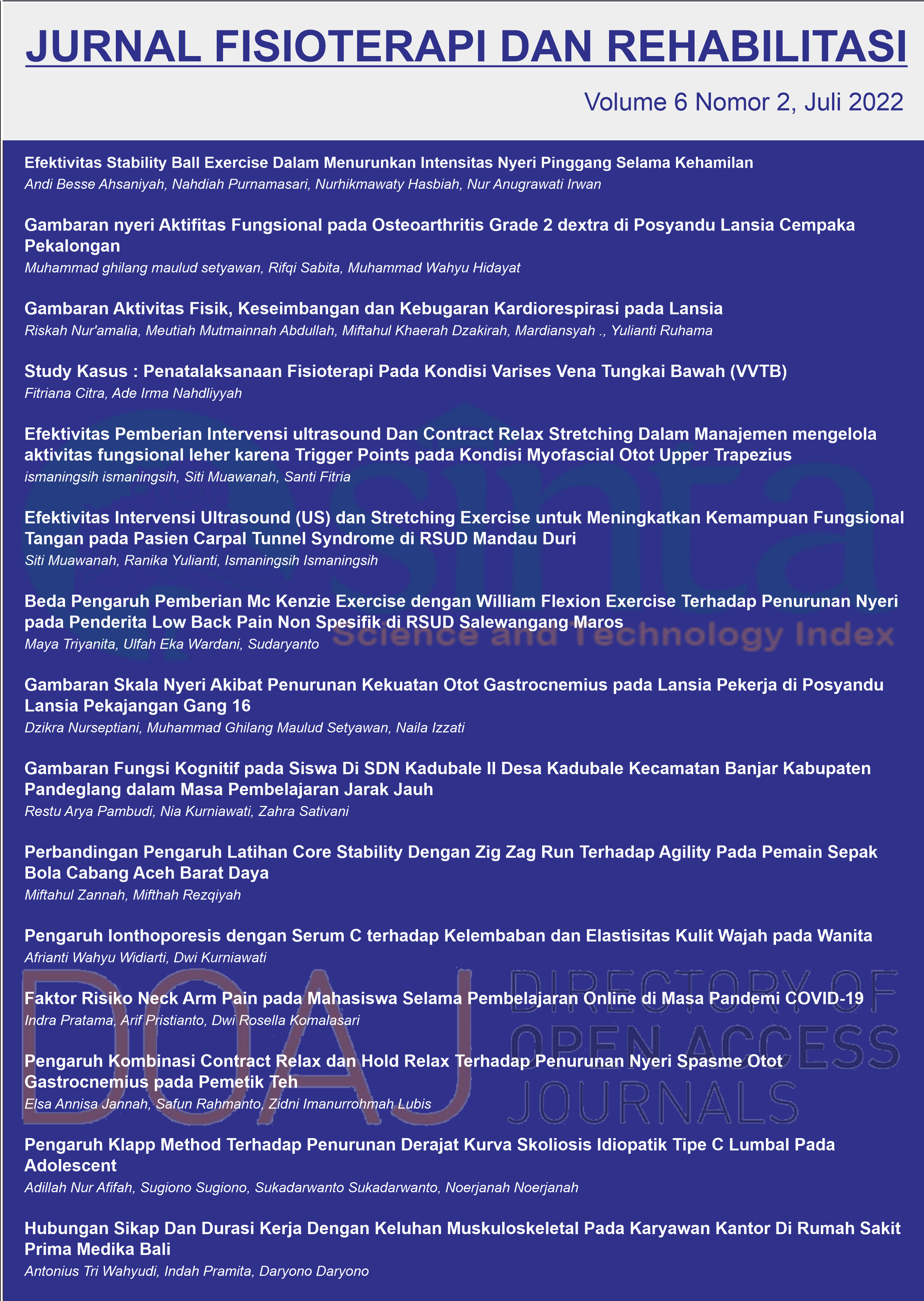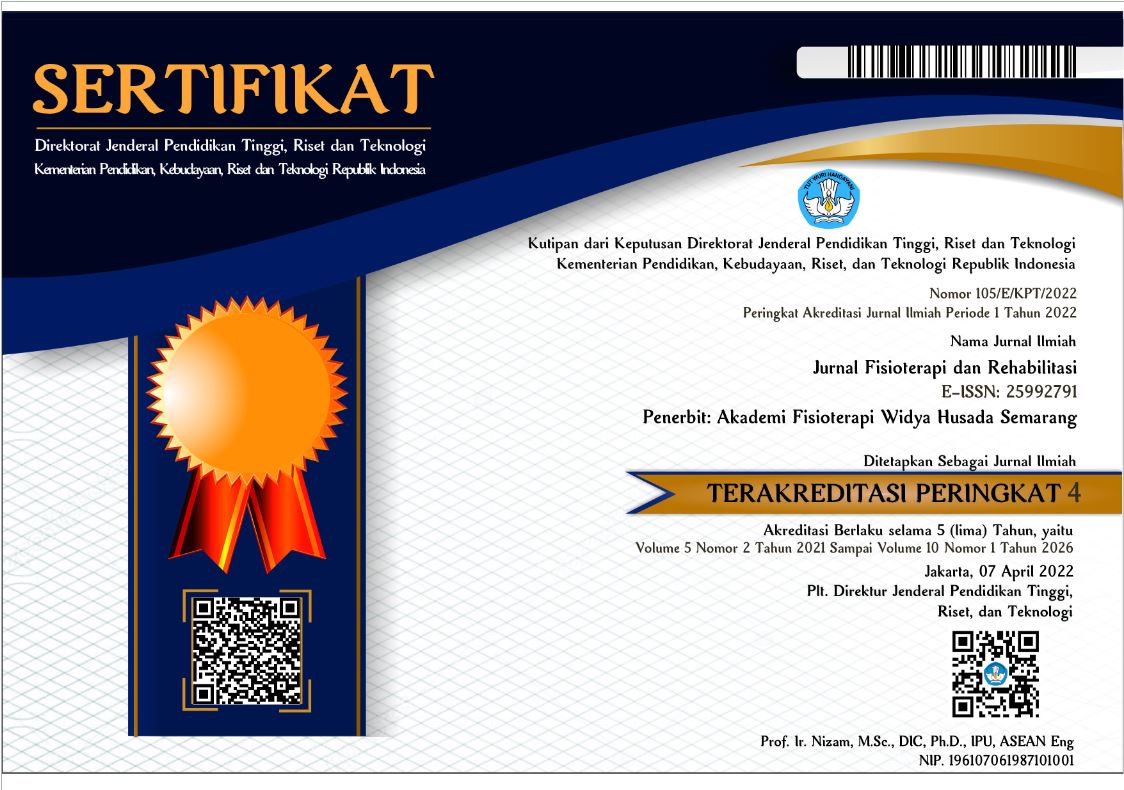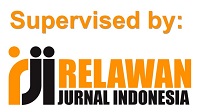Pengaruh Ionthoporesis dengan Serum C terhadap Kelembaban dan Elastisitas Kulit Wajah pada Wanita
The Effect of Ionthoporesis With Serum C on Moisture and Elasticity of Facial Skin in Women
Abstract
Latar Belakang: Kulit merupakan organ terbesar dalam tubuh manusia yang memberikan perlindungan. Proses menua pada kulit secara intrinsik dapat dipercepat akibat berbagai faktor ekstrinsik yang didominasi oleh paparan sinar matahari. Tujuan: Tujuan penelitian ini adalah untuk mengetahui Pengaruh Ionthoporesis dengan Serum C terhadap Kelembaban dan Elastisitas Kulit Wajah pada Wanita. Metode: Desain yang digunakan dalam penelitian ini adalah Quasi experimental dengan rancangan one group pretest – posttest with control design. Hasil: Uji Independent Samples Test kelembaban Kelompok I dan II menghasilkan nilai p 0.000 yang berarti ada perbedaan secara bermakna. Uji Independent Samples Test elastisitas Kelompok I dan II menghasilkan nilai p 0.017 yang berarti ada perbedaan secara bermakna. Kesimpulan: Kesimpulannya pemberian serum C dengan metode ionthophoresis lebih dapat meningkatkan kelembaban dan elastisitas kulit wajah dibandingkan dengan pemberian serum C dengan dioles.
Downloads
References
Alexander, A., Dwivedi, S., Ajazuddin, Giri, T. K., Saraf, S., Saraf, S., & Tripathi, D. K. (2012). Approaches for breaking the barriers of drug permeation through transdermal drug delivery. Journal of Controlled Release, 164(1), 26–40. https://doi.org/10.1016/j.jconrel.2012.09.017
Amanati, S., Purnomo, D., & Abidin, Z. (2017). Pengaruh Infra Red dan Elektrical Stimulation serta Massage terhadap Kasus Bell’s Palsy Dekstra. Jurnal Fisioterapi Dan Rehabilitasi, 1(1), 9–15. https://doi.org/10.33660/jfrwhs.v1i1.5
Bakshi, P., Vora, D., Hemmady, K., & Banga, A. K. (2020). Iontophoretic skin delivery systems: Success and failures. International Journal of Pharmaceutics, 586(May), 119584. https://doi.org/10.1016/j.ijpharm.2020.119584
Basketter, D., Johansen, J. D., McFadden, J., & Søsted, H. (2011). Hair dyes. In Contact Dermatitis (Fifth Edition). https://doi.org/10.1007/978-3-642-03827-3_34
Beri, K. (2016). Breathing to younger skin: “reversing the molecular mechanism of skin aging with yoga.” Future Science OA, 2(2). https://doi.org/10.4155/fsoa-2016-0015
Calderwood, S. K., Murshid, A., & Prince, T. (2009). The shock of aging: Molecular chaperones and the heat shock response in longevity and aging - A mini-review. Gerontology, 55(5), 550–558. https://doi.org/10.1159/000225957
Durai, P. C., Thappa, D. M., Kumari, R., & Malathi, M. (2012). Aging in elderly: Chronological versus photoaging. Indian Journal of Dermatology, 57(5), 343–352. https://doi.org/10.4103/0019-5154.100473
Examiner, P., & Brown, M. A. (2008). ( 12 ) United States Patent. 2(12).
Few, J. W. (2010). Cosmetic Dermatology for Skin of Color. Aesthetic Surgery Journal, 30(2), 275–276. https://doi.org/10.1177/1090820x10369155
Ganceviciene, R., Liakou, A. I., Theodoridis, A., Makrantonaki, E., & Zouboulis, C. C. (2012). Skin anti-aging strategies. 4(3), 308–319.
Haerani, A., Chaerunisa, A., Yohana, & Subarnas, A. (2018). Artikel Tinjauan: Antioksidan Untuk Kulit. Farmaka, Universitas Padjadjaran, Bandung, 16(2), 135–151.
Limtrakul, P., Yodkeeree, S., Thippraphan, P., Punfa, W., & Srisomboon, J. (2016). Anti-aging and tyrosinase inhibition effects of Cassia fistula flower butanolic extract. BMC Complementary and Alternative Medicine, 16(1), 1–9. https://doi.org/10.1186/s12906-016-1484-3
Nabila, Y. A., Damayanti, D., Handayani, S., & Setyaningrum, T. (2021). The Effect of Lifestyle on Skin Aging. Berkala Ilmu Kesehatan Kulit Dan Kelamin, 33(2), 110. https://doi.org/10.20473/bikk.v33.2.2021.110-115
Noh, E. M., Park, J., Song, H. R., Kim, J. M., Lee, M., Song, H. K., Hong, O. Y., Whang, P. H., Han, M. K., Kwon, K. B., Kim, J. S., & Lee, Y. R. (2016). Skin aging-dependent activation of the PI3K signaling pathway via downregulation of PTEN increases intracellular ROS in human dermal fibroblasts. Oxidative Medicine and Cellular Longevity, 2016. https://doi.org/10.1155/2016/6354261
Ogawa, K., Funaba, M., Mathews, L. S., & Mizutani, T. (2000). Activin A Stimulates Type IV Collagenase (Matrix Metalloproteinase-2) Production in Mouse Peritoneal Macrophages. The Journal of Immunology, 165(6), 2997–3003. https://doi.org/10.4049/jimmunol.165.6.2997
Oresajo, C., Stephens, T., Hino, P. D., Law, R. M., Yatskayer, M., Foltis, P., Pillai, S., & Pinnell, S. R. (2008). Protective effects of a topical antioxidant mixture containing vitamin C. ferulic acid, and phloretin against ultraviolet-induced photodamage in human skin. Journal of Cosmetic Dermatology, 7(4), 290–297. https://doi.org/10.1111/j.1473-2165.2008.00408.x
Rattanawiwatpong, P., Wanitphakdeedecha, R., Bumrungpert, A., & Maiprasert, M. (2020). Anti-aging and brightening effects of a topical treatment containing vitamin C, vitamin E, and raspberry leaf cell culture extract: A split-face, randomized controlled trial. Journal of Cosmetic Dermatology, 19(3), 671–676. https://doi.org/10.1111/jocd.13305
Schagen, S. K., Zampeli, V. A., Makrantonaki, E., & Zouboulis, C. C. (2012). Discovering the link between nutrition and skin aging. Dermato-Endocrinology, 4(3). https://doi.org/10.4161/derm.22876
Wathoni, N., & Panji Luhur, M. (2012). Effect of iontophoresis and propylene glycol on the in vitro diffusion of ethyl vitamin c cream. Res J Pharm. App Sci. Int. Res J Pharm. App Sci. Vol-II, 2(4), 31–34.
Yi, N., & Chiang, Z. (2017). Topical Vitamin C and the Skin. Jcad Journal of Clinical and Aesthetic Dermatology, 14(7), 14–17.

This work is licensed under a Creative Commons Attribution 4.0 International License.
The use of the article will be governed by the Creative Commons Attribution license as currently displayed on Creative Commons Attribution 4.0 International License.
Author’s Warranties
The author warrants that the article is original, written by stated author(s), has not been published before, contains no unlawful statements, does not infringe the rights of others, is subject to copyright that is vested exclusively in the author and free of any third party rights, and that any necessary written permissions to quote from other sources have been obtained by the author(s).
User Rights
JFR's spirit is to disseminate articles published are as free as possible. Under the Creative Commons license, JFR permits users to copy, distribute, display, and perform the work. Users will also need to attribute authors and JFR on distributing works in the journal.
Rights of Authors
Authors retain all their rights to the published works, such as (but not limited to) the following rights;
- Copyright and other proprietary rights relating to the article, such as patent rights,
- The right to use the substance of the article in own future works, including lectures and books,
- The right to reproduce the article for own purposes,
- The right to self-archive the article
Co-Authorship
If the article was jointly prepared by other authors, any authors submitting the manuscript warrants that he/she has been authorized by all co-authors to be agreed on this copyright and license notice (agreement) on their behalf, and agrees to inform his/her co-authors of the terms of this policy. JFR will not be held liable for anything that may arise due to the author(s) internal dispute. JFR will only communicate with the corresponding author.
Miscellaneous
JFR will publish the article (or have it published) in the journal if the article’s editorial process is successfully completed. JFR's editors may modify the article to a style of punctuation, spelling, capitalization, referencing and usage that deems appropriate. The author acknowledges that the article may be published so that it will be publicly accessible and such access will be free of charge for the readers as mentioned in point 3.












